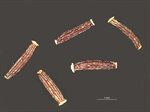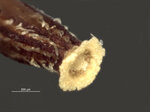Taxonomy
Crassocephalum crepidioides (Benth.) S.Moore, J. Bot. 50: 211. 1912.Common synonyms
Gynura crepidioides Benth., Niger Fl. [W. J. Hooker]. 438. 1849.Common name
Redflower ragleaf, fireweed, thickhead
Description
Propagule or dispersal unit is the fruit with pappus. Fertile part 2-2.5 mm long, 0.4-0.6 mm wide, in side view widest in upper part (obovoid), widest in lower part (ovoid) or widest in the middle, +/- straight, the upper (apical) end narrowing, in cross-section round (terete) or flattened, basal scar (carpopodium) pronounced and well-differentiated, central, beak (=thinner sterile stalk between seed and pappus) absent, wings absent, fruit surface dark brown or reddish to pink, smooth (except at cellular level), with simple straight hairs, thickened margin absent, longitudinal ribs present, 8-10, their surfaces smooth, with no hairs (glabrous).
Pappus type bristles / hairs, pappus elements all +/- similar, up to (8-)10-14(-15) mm long, pappus elements numerous, elements falling off individually, the individual bristles smooth, +/- equal width along length, white / translucent.
Notes: According to the Flora of Australia, the pappus can be as short as 8 mm, but that was not observed among the specimens examined for this key. The pappus bristles are deciduous and will consequently most likely be missing in most cases when this species is encountered. Similar to Senecio but distinctive in its purplish colour.
Ecology
Herb, fruit wind-dispersed but somewhat limited in distance due to early loss of pappus hairs. Tropical; needs open, light areas. Riverbanks, rail- and roadsides, agricultural land, grasslands, rocky areas, open shrublands, urban areas.
Native range
Widespread in tropical Africa including Madagascar.
Introduced range
United States (Hawai'i, Florida), Costa Rica, Carribbean, tropical Asia, Papua New Guinea, Australia, Pacific Islands.
Weed status within Australia
WA Declared Pest s12 (C1 Prohibited).

